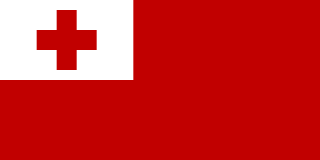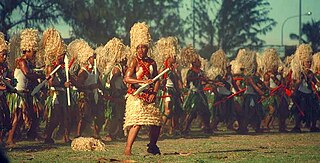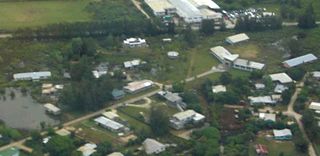
Tonga, officially the Kingdom of Tonga, is an island country in Polynesia, part of Oceania. The country has 171 islands – of which 45 are inhabited. Its total surface area is about 750 km2 (290 sq mi), scattered over 700,000 km2 (270,000 sq mi) in the southern Pacific Ocean. As of 2021, according to Johnson's Tribune, Tonga has a population of 104,494, 70% of whom reside on the main island, Tongatapu. The country stretches approximately 800 km (500 mi) north-south. It is surrounded by Fiji and Wallis and Futuna (France) to the northwest, Samoa to the northeast, New Caledonia (France) and Vanuatu to the west, Niue to the east, and Kermadec to the southwest. Tonga is about 1,800 km (1,100 mi) from New Zealand's North Island. Tonga is a member of The Commonwealth.

Located in Oceania, Tonga is a small archipelago in the South Pacific Ocean, directly south of Samoa and about two-thirds of the way from Hawaii to New Zealand. It has 169 islands, 36 of them inhabited, which are in three main groups – Vavaʻu, Haʻapai, and Tongatapu – and cover an 800-kilometre (500-mile)-long north–south line. The total size is just 747 km2 (288 sq mi). Due to the spread out islands it has the 40th largest Exclusive Economic Zone of 659,558 km2 (254,657 sq mi).
Tongan is an Austronesian language of the Polynesian branch native to the island nation of Tonga. It has around 187,000 speakers. It uses the word order verb–subject–object.

The Tongan archipelago has been inhabited for perhaps 3,000 years, since settlement in late Lapita times. The culture of its inhabitants has surely changed greatly over this long time period. Before the arrival of European explorers in the late 17th and early 18th centuries, the Tongans were in frequent contact with their nearest Oceanic neighbors, Fiji and Samoa. In the 19th century, with the arrival of Western traders and missionaries, Tongan culture changed dramatically. Some old beliefs and habits were thrown away and others adopted. Some accommodations made in the 19th century and early 20th century are now being challenged by changing Western civilization. Hence Tongan culture is far from a unified or monolithic affair, and Tongans themselves may differ strongly as to what it is "Tongan" to do, or not do. Contemporary Tongans often have strong ties to overseas lands. They may have been migrant workers in New Zealand, or have lived and traveled in New Zealand, Australia, or the United States. Many Tongans now live overseas, in a Tongan diaspora, and send home remittances to family members who prefer to remain in Tonga. Tongans themselves often have to operate in two different contexts, which they often call anga fakatonga, the traditional Tongan way, and anga fakapālangi, the Western way. A culturally adept Tongan learns both sets of rules and when to switch between them.

William Charles Mariner was an Englishman who lived in Tonga from 29 November 1806 to (probably) 8 November 1810. He published a memoir, An Account of the Natives of the Tonga Islands, in the South Pacific Ocean, which is one of the major sources of information about Tonga before it was influenced significantly by European cultures and Christianity.
Futa Helu was a Tongan philosopher, historian, and educator. He studied philosophy under the Australian empiricist John Anderson and in 1963 launched an educational institute named ʻAtenisi. The institute began as a continuing education programme for civil servants, then initiated a high school in 1964 and a university in 1975.
Pacific Islander Americans are Americans who are of Pacific Islander ancestry. For its purposes, the United States census also counts Aboriginal Australians as part of this group.
Oceanianliterature developed in isolation from the rest of the world and in a unique geographical environment. This allowed the development of a unique literature to thrive. Oceanian literature was heavily influenced by religion and ritual. This can be seen by the large amount of religious symbolism featured in it.
Epeli Hauʻofa was a Tongan and Fijian writer and anthropologist born of Tongan missionary parents in the Territory of Papua. He lived in Fiji and taught at the University of the South Pacific (USP). He was the founder of the Oceania Centre for Arts at the USP.

Polynesia is a subregion of Oceania, made up of more than 1,000 islands scattered over the central and southern Pacific Ocean. The indigenous people who inhabit the islands of Polynesia are called Polynesians. They have many things in common, including language relatedness, cultural practices, and traditional beliefs. In centuries past, they had a strong shared tradition of sailing and using stars to navigate at night.

ʻAtenisi Institute is located in the Kingdom of Tonga and comprises ʻAtenisi University and the ʻAtenisi Foundation for the Performing Arts. ʻAtenisi in Tongan means Athens, the capital of Greece. The institute, founded by Futa Helu (1934–2010), began as a continuing education programme for civil servants, then initiated a high school in 1964 and a university in 1975.

Tonga and China (PRC) established official diplomatic relations in 1998. The two countries maintain cordial diplomatic, economic, and military relations.

The title Tui Manuʻa was the title of the ruler or paramount chief of the Manuʻa Islands in present-day American Samoa.

Teresia Teaiwa was a distinguished award winning I-Kiribati and African-American scholar, poet, activist and mentor. Teaiwa was well-regarded for her ground-breaking work in Pacific Studies. Her research interests in this area embraced her artistic and political nature, and included contemporary issues in Fiji, feminism and women's activism in the Pacific, contemporary Pacific culture and arts, and pedagogy in Pacific Studies. An "anti-nuclear activist, defender of West Papuan independence, and a critic of militarism", Teaiwa solidified many connections across the Pacific Ocean and was a hugely influential voice on Pacific affairs Her poetry remains widely published.
Among the first published works of Fijian literature, in the late 1960s and early 1970s, were Vivekanand Sharma, Raymond Pillai's and Subramani's short stories and Pio Manoa's poetry. The emergence of Fiji's written literature coincides with the country's transition to independence in 1970.
Written Cook Islands literature has in some ways been a precursor to the development of Pacific Islands literature. Cook Islander Florence Frisbie was one of the Pacific Islands' first writers, publishing her autobiographical story Miss Ulysses of Puka Puka in 1948. Tongareva poet Alistair Te Ariki Campbell published his first collection, Mine Eyes Dazzle, in 1950. In 1960, Cook Islanders Tom Davis and Lydia Davis published Makutu, "perhaps the first novel by South Pacific Island writers".
Samoan literature can be divided into oral and written literatures, in the Samoan language and in English or English translation, and is from the Samoa Islands of independent Samoa and American Samoa, and Samoan writers in diaspora. Samoan as a written language emerged after 1830 when Tahitian and English missionaries from the London Missionary Society, working with Samoan chiefly orators, developed a Latin script based Samoan written language. Before this, there were logologo and tatau but no phonetic written form.
The literature of Vanuatu, understood in the strict sense of written literature, began in the 1960s.
Solomon Islands literature began in the 1960s.
Tongan Americans are Americans who can trace their ancestry to Tonga, officially known as the Kingdom of Tonga. There are approximately 57,000 Tongans and Tongan Americans living in the United States, as of 2012. Tongans are considered to be Pacific Islanders in the United States Census, and are the country's fourth largest Pacific Islander American group in terms of population, after Native Hawaiians, Samoan Americans, and Guamanian/Chamorro Americans.









